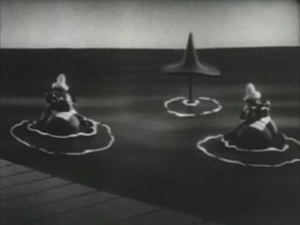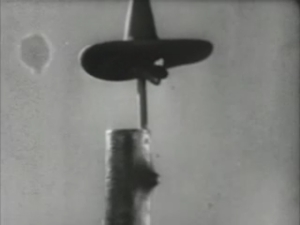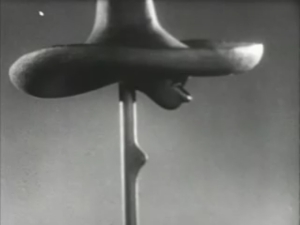The Lady Said No
Several years ago – a veritable eternity in Internet Time – Jerry Beck and Amid Amidi, the animation historians/enthusiasts who run the venerable and essential site Cartoon Brew, launched a subsite, Cartoon Brew Films, which they used as a venue for hosting and distributing, for a small fee, a number of cartoons that had slipped through the cracks of film history. The very first film featured on Cartoon Brew Films was Frank Tashlin’s unusual 1946 stop-motion film The Lady Said No, which had fallen into the public domain.
At the time, I was researching my dissertation on Tashlin, so I eagerly downloaded the film, and felt obliged to submit a lengthy-ish comment to Cartoon Brew Films. Alas, Cartoon Brew Films has gone the way of the dodo, taking with it my comments.
The comments, I assure you, were no great loss, but I have nevertheless and perhaps ill-advisedly used them as the basis for my notes below on The Lady Said No, which you can watch below, via YouTube. It is not the highest-quality version of this film, but, then, we’re fortunate that it survives at all. I cannot account for the flickering between color and black and white.
The Lady Said No was made using a labor-intensive stop-motion process called “replacement animation,” whereby, for instance, animators would craft, for a single character, multiple heads, each with a different facial expression or lip-position. The heads would fit into the character’s body using some variation of a ball-and-socket joint, and would be swapped out as often as necessary, frame-by-frame, to convey changes in facial expression and/or lip movement. As indicated in the link just above, replacement animation is most strongly associated with George Pal, best known for his “Puppetoon” films, but most beloved by me for 7 Faces of Dr. Lao (1964), an oddball movie that gives the great Tony Randall (whom I interviewed once, not a year before he died) a chance to ham it up under layers of crazy make-up.
Modern audiences are most familiar with replacement animation from the films The Nightmare before Christmas and the works of Aardman Studios, makers of the delightful Wallace & Gromit films (notably the truly brilliant Wallace & Gromit in the Curse of the Were-Rabbit), and Chicken Run.
Here is a fascinating bit of film history: a photo essay, from a 1946 issue of Popular Science, about the process used to make this very film. I’ve scanned and uploaded the three-page spread as two (rather large) PDF files: one PDF of the two-page color spread, and one black-and-white page. Some edges got cut off and you’ll have to pardon the three-ring-binder punchholes. The article is really worth a look – the photos are great, and you get some sense of the massive amounts of work required to produce a film that has, 65 years later, been almost entirely forgotten.
The full citation information is:
Bob Newman [photgrapher], “Six-Inch Wax Dolls Are New Stars in Filmland,” Popular Science, Vol. 148, No. 5 (May 1946), pp. 108-109.
So The Lady Said No – whose main character, by the way, is meant to resemble legendary Mexican comedian Cantinflas – was made using an unusual animation process, but is also unusual for the ways in which it combines stop-motion technique with traditional 2D animation. Notice, for instance, the “motion lines” when the main character dashes away at around 1:12; the ripples that emanate from the bodies of the waterlogged singers around 4:33; and the smoke clouds at 5:44.

1:12: The setting and puppets are 3D; so far as I can tell, the streaky "motion lines" were painted onto a flat surface.
This was Tashlin’s first foray into stop-motion, which makes these creative techniques all the more impressive. One of my central claims about Tashlin is that he was unusually visually inventive, and The Lady Said No would seem to confirm that idea.
In that stop-motion animation can depict (not just represent) three-dimensionality, it is tempting to see it as “closer” to live-action filmmaking than is 2-D animation. Much of the literature on Tashlin accounts for his career within the bounds of an uncomplicated arc: his work “evolves” and becomes more sophisticated as he moves from animation to live-action. This is too simplistic; it is in fact one of the points with which, in my upcoming book on Tashlin, I take issue most strongly. Tashlin is usefully considered as a gifted visual artist. The print cartoons he did in the 1930s, for instance, are no more or less “sophisticated” than his feature films of the 1950s; they are all products of a restless, curious visual/comic intelligence.
One of the continuities between The Lady Said No and much of Tashlin’s other works is his reliance on tried-and-true comic forms, most plainly the gag/topper/topper-topper structure. Tashlin is a master of setting up gags, varying them, and amplifying them. One of the best in The Lady Said No has to do with the long-necked singer’s Adam’s apple.
The first time we see the Adam’s apple, in a close-up at 1:34, it is funny in its own right, as it slides up and down the singer’s neck.
The second time we see the Adam’s apple, at 4:37, Tashlin emphasizes the up-and-down movement by echoing it in the movement of the fish’s eyeballs.
The third time (5:59), the character sings from inside a cactus, and the cactus’s skin (hide? bark?) bulges and moves along with the Adam’s apple behind it: the gag is thus intensified.
The last time this gag appears (7:11), Tashlin treats it to a variation that ties in beautifully with the culmination of the film’s narrative. We have a new singer – one of the main character’s many, many babies – whose acrobatic Adam’s apple completes this gag cycle as it brings closure to the story: woo whom you want, but be prepared for the consequences. Tashlin makes his point about the dangers of romance (a theme common in his work) with, as is typical, a sight gag.
The camera is quite mobile in The Lady Said No, moving along all axes with great vigor. Tashlin often composes shots from unusual angles, but we should not take this as a sign of his becoming “more cinematic”: animation is film, too, and is therefore no less ontologically cinematic than any other film form.
I prefer to see the film’s several, striking moving-camera shots as fulfilling two goals. First, they are evidence of Tashlin’s interest in undermining animation’s reliance on the frontal, “proscenium”-style staging that made even some of the best Looney Tunes and Merrie Melodies somewhat “flatter” than they might otherwise have been – see, for instance, most of Friz Freleng’s (generally excellent) 1930s films. The rapid camera movement onto the “stage” at 7:25 is a particularly witty gesture, in this context.
Second, and more importantly, Tashlin moves his camera and varies his compositions whenever such a gesture will clarify or intensify his film’s comedy. The several shots of the parade of waiters are fine examples of this tendency.
 These shots are taken from “Dutch” angles, the better to render abstract the shapes of the dishes, and the better to emphasize the enormity of the meal ordered by the Lady. Another fine example: Tashlin tracks the camera to follow our hero as he is dragged behind the wagon – what better way to emphasize the humor that underpins his dilemma? Comedy was Tashlin’s great muse, and he followed it throughout his varied, fascinating career.
These shots are taken from “Dutch” angles, the better to render abstract the shapes of the dishes, and the better to emphasize the enormity of the meal ordered by the Lady. Another fine example: Tashlin tracks the camera to follow our hero as he is dragged behind the wagon – what better way to emphasize the humor that underpins his dilemma? Comedy was Tashlin’s great muse, and he followed it throughout his varied, fascinating career.
As discussed above, the basis for this essay was a long comment that I posted to the late, lamented blog Cartoon Brew Films. I would like to extend special thanks to Jerry Beck and Cartoon Brew for graciously granting permission for me to repost my comments, and to Mark Kausler, without whom The Lady Said No would likely be lost entirely.
Posted on October 18, 2011, in Animation, Comedy, Film, Tashlin and tagged animation, cartoons, comedy, film, franktashlin, hollywood, tashlin. Bookmark the permalink. Leave a comment.









Leave a comment
Comments 0